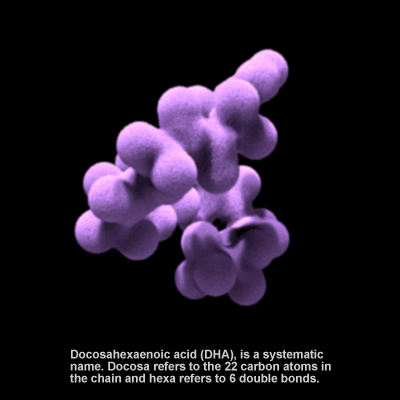What Are Essential Fatty Acids?

Docosahexaenoic acid (DHA) is an Omega-3 fatty acid. It is essential for proper functioning of the brain in both adults and infants. DHA concentrations in breast milk range from 0.07-1.0% of total fatty acids and are influenced by the amount of fatty fish in the mother's diet. In the US, infant formula has been supplemented with DHA since 2001. Research suggests that DHA contributes to numerous nervous system functions such as increased visual acuity, neurogenesis and synaptogenesis, and lowering the risk for cardiovascular disease. It is highly concentrated in the brain and eye.
|
Fatty acids that can’t be synthesized by the body and therefore are required to be supplied in the diet are called Essential Fatty Acids (EFAs). They are “essentials” for the body to function and are obtainable from food sources.
There are two families of EFAs: Omega-3 and Omega-6. Omega-9 is necessary yet “non-essential” because the body can manufacture a modest amount on its own, provided essential EFAs are present.
The human body needs EFAs to manufacture and repair cell membranes, enabling the cells to obtain optimum nutrition and expel harmful waste products. A primary function of EFAs is the production of prostaglandins, which regulate body functions such as heart rate, blood pressure, blood clotting, fertility, conception, and play a role in immune function by regulating inflammation and encouraging the body to fight infection. EFAs are also needed for proper growth in children, particularly for neural development and maturation of sensory systems, with male children having higher needs than females. Fetuses and breast-fed infants also require an adequate supply of EFAs through the mother's dietary intake.
Symptoms of essential fatty acids deficiency include cancer, insulin resistance, depression, poor immunity, hypertension, decreased memory and mental health, asthma, diabetes, increased tendency of blood clotting, growth retardation, irregular heartbeat, increased triglycerides and so on.
Omega-3 essential fatty acid is lacking in most Western diets. The balance of Omega-6 essential fatty acid and Omega-3 essential fatty acid should be four or five Omega-6 to each Omega-3 for a good balance. We get ample amounts of Omega-6 in the typical Western diet. The ratio in this diet is between 10 and 20 to 1 in favor of Omega-6.
Good food sources of Omega-3 EFAs are nuts, soybean, canola oil, walnut oil, flaxseed oil. Fish, especially cold water fish such as salmon, bluefish, herring, tuna, cod, flounder, mackerel and shrimp are also good sources.
|